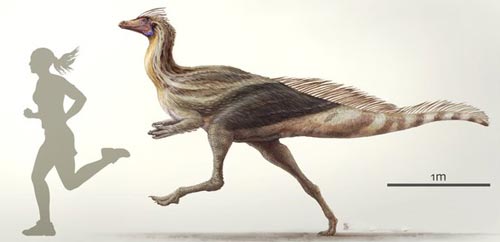Arkansaurus fridayi – A Basal Ornithomimosaur
Dinosaur fossils unearthed in Lockesburg, (Arkansas), nearly fifty years ago have been formally described in a scientific journal. Writing in the academic publication the “Journal of Vertebrate Palaeontology”, researchers have assigned the fossil elements representing the right hind foot of an “ostrich mimic dinosaur” to a basal position in the Ornithomimosauria clade. The dinosaur, named Arkansaurus fridayi, was previously thought to represent an animal related to Ornitholestes. However, the researchers, led by palaeontologist ReBecca Hunt-Foster, who works at the Bureau of Land Management and is based in Utah, a U.S. state more accustomed to dinosaur fossils than “The Natural State”, suggest that A. fridayi is more primitive than contemporaneous Asian ornithomimosaurs.
An Illustration of an Ornithomimid Dinosaur (Ornithomimus)

Picture credit: Julius Csotonyi
The State Dinosaur of Arkansas
Although only a handful of bones have been found, palaeontologists have built up a picture of this fleet-footed, lizard-hipped dinosaur, by comparing the fossil pedal (foot) material to more complete and better-known ornithomimids such as Struthiomimus and Ornithomimus that roamed western North America in the Late Cretaceous.
These Late Cretaceous ornithomimids lived on a landmass called Laramidia, it was separated from the eastern part of the continent by a shallow sea (the Western Interior Seaway). Arkansas and consequently, Arkansaurus fridayi was on the other side of this waterway and very little is known about the dinosaurs that existed on this landmass (Appalachia). The right foot, is the only known evidence of saurischian dinosaurs from Arkansas, despite the lack of skeletal information and the absence of a formal scientific description, last year, this dinosaur was named the official state fossil of Arkansas.
ReBecca Hunt-Foster, started working on the fossils more than a decade ago, whilst studying at the University of Arkansas. Her co-author of the scientific paper, James Quinn works at the Department of Geosciences (University of Arkansas), they postulate these fossils will help to improve our understanding of the radiation and geographical dispersal of ornithomimosaurs. Arkansaurus roamed Appalachia some 113 million years ago (Albian-Aptian) faunal stage of the Early Cretaceous, it may well have been an ancestor of the Late Cretaceous “ostrich mimics” such as Ornithomimus.
An Illustration of Arkansaurus fridayi (Estimated Scale)

Picture credit: Brian Engh
Not Much Known About North American Early Cretaceous “Ostrich Mimics”
The fossilised foot bones come from the Lower Cretaceous Trinity Group. Exposures in Texas have yielded plenty of dinosaur fossils, but as yet, no ornithomimids have been named from the Texas material, in fact Arkansaurus represents the second-oldest “ostrich mimic” dinosaur known from the whole of North America.
The oldest ornithomimid from North America described to date is Nedcolbertia, (N. justinhofmanni) which is known from fragmentary remains representing several juveniles found in Early Cretaceous sediments deposited in Utah. Such is the paucity of the fossil material of Early Cretaceous ornithomimids from North America, that there is something like a fifteen-million-year gap between Nedcolbertia and the newly described Arkansaurus.
Vertebrate Palaeontologist ReBecca Hunt-Foster with a Cast of the Foot Bones
Picture credit: R. Hunt-Foster
Arkansaurus fridayi – A Lucky Fossil Discovery
The trivial name honours farmer Robert Friday who discovered the fossils on his farm back in 1972. He was checking on his livestock when he spotted some bones in a ditch excavated by a road construction crew. Any other parts of the skeleton that might have been preserved were probably lost as the construction crew worked. Hunt-Foster and her colleagues are hoping to learn more about Appalachian ornithomimosaurs from any future fossil finds from Arkansas. They hope to build up a picture of the Early Cretaceous palaeofauna and they have speculated that these types of dinosaurs may have originated in Europe and that they are not closely related to other, better known “ostrich mimics” from Asia.
To read an article about evidence of Appalachian horned dinosaurs: Horned Dinosaur Tooth Discovered in Northern Mississippi.
The scientific paper: “A New Ornithomimosaur from the Lower Cretaceous Trinity Group of Arkansas” by ReBecca K. Hunt and James H. Quinn published in the Journal of Vertebrate Palaeontology.
Visit the Everything Dinosaur website: Everything Dinosaur.







I found egg with embryo in Clay county arkansas
If you feel that you have found something interesting then we suggest you enquire at your local museum who should be able to put you in touch with a geologist, palaeontologist or some other qualified person who can help you identify the object.